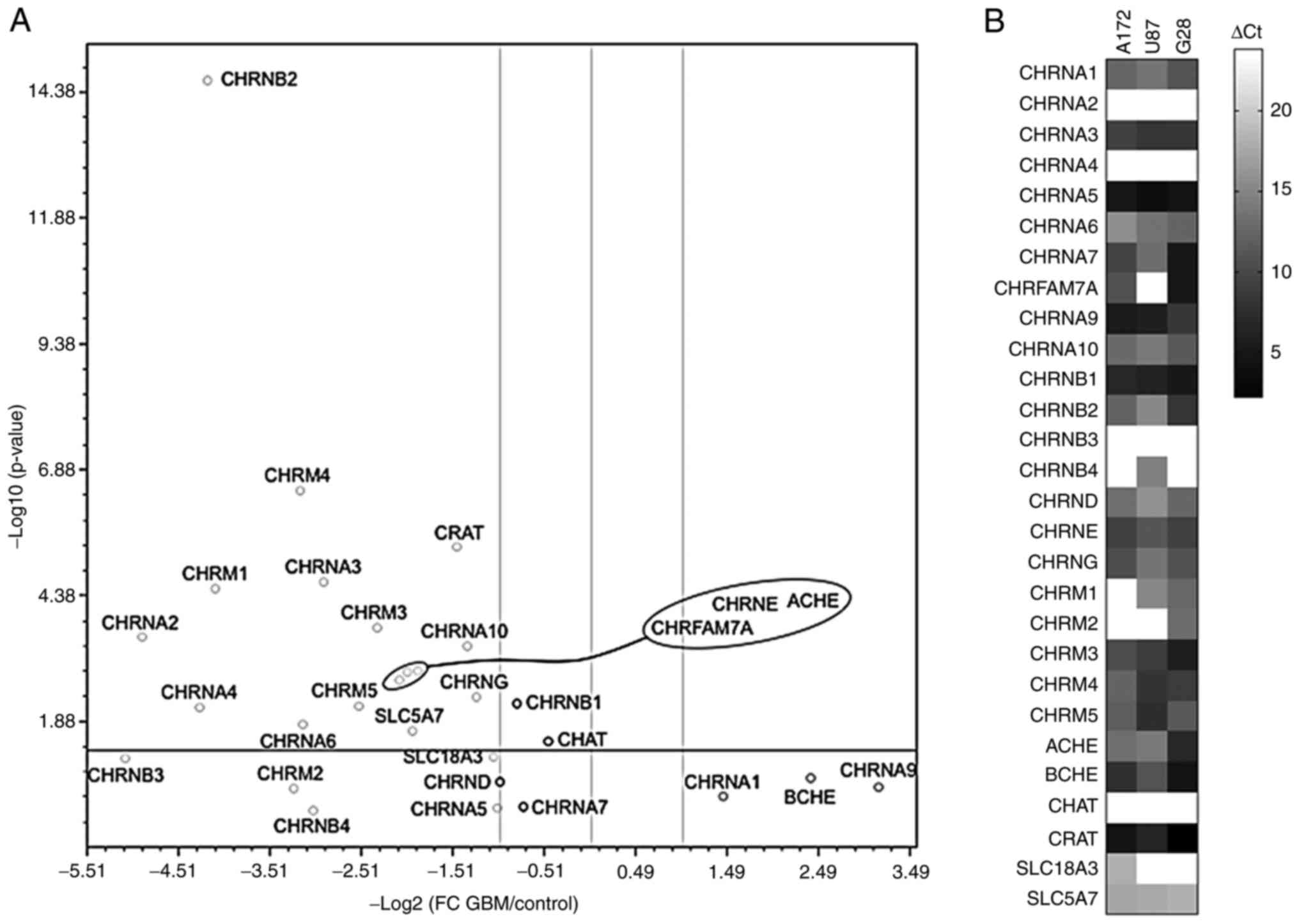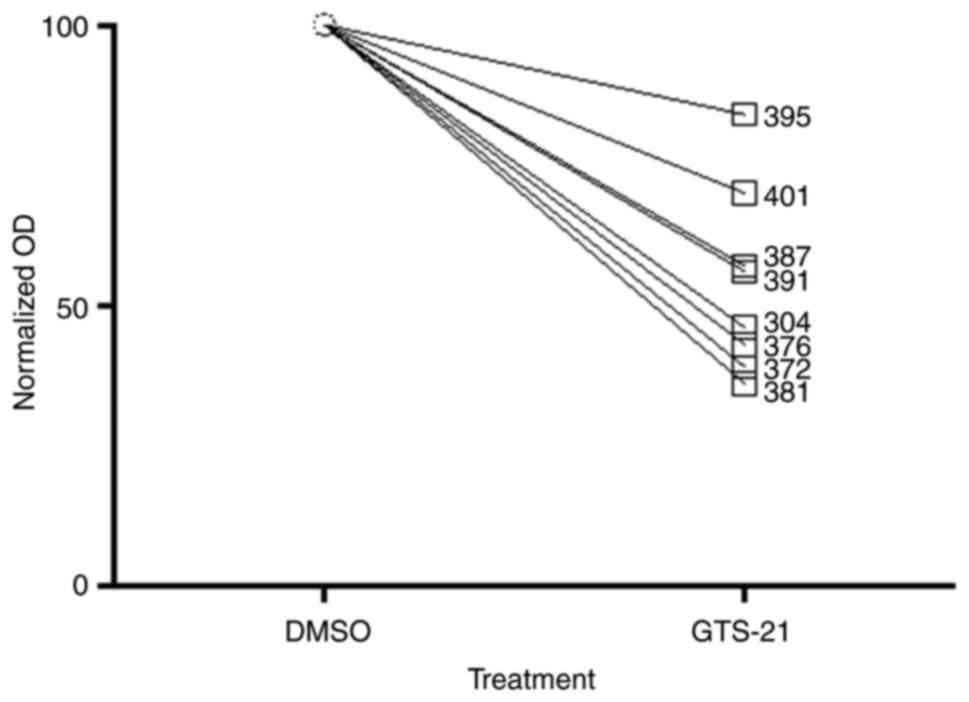|
1
|
Krex D, Klink B, Hartmann C, von Deimling
A, Pietsch T, Simon M, Sabel M, Steinbach JP, Heese O, Reifenberger
G, et al: Long-term survival with glioblastoma multiforme. Brain.
130:2596–2606. 2007. View Article : Google Scholar : PubMed/NCBI
|
|
2
|
Stupp R, Mason WP, van den Bent MJ, Weller
M, Fisher B, Taphoorn MJ, Belanger K, Brandes AA, Marosi C, Bogdahn
U, et al: Radiotherapy plus Concomitant and Adjuvant Temozolomide
for Glioblastoma. N Engl J Med. 352:987–996. 2005. View Article : Google Scholar : PubMed/NCBI
|
|
3
|
Maher EA: Malignant glioma: Genetics and
biology of a grave matter. Genes Dev. 15:1311–1333. 2001.
View Article : Google Scholar : PubMed/NCBI
|
|
4
|
Bonavia R, Inda MM, Cavenee WK and Furnari
FB: Heterogeneity maintenance in glioblastoma: A social network.
Cancer Res. 71:4055–4060. 2011. View Article : Google Scholar : PubMed/NCBI
|
|
5
|
Hadjipanayis CG and Van Meir EG: Brain
cancer propagating cells: Biology, genetics and targeted therapies.
Trends Mol Med. 15:519–530. 2009. View Article : Google Scholar : PubMed/NCBI
|
|
6
|
Paez-Gonzalez P, Asrican B, Rodriguez E
and Kuo CT: Identification of distinct ChAT+ neurons and
activity-dependent control of postnatal SVZ neurogenesis. Nat
Neurosci. 17:934–942. 2014. View
Article : Google Scholar : PubMed/NCBI
|
|
7
|
Kuol N, Stojanovska L, Apostolopoulos V
and Nurgali K: Role of the nervous system in tumor angiogenesis.
Cancer Microenviron. 11:1–11. 2018. View Article : Google Scholar : PubMed/NCBI
|
|
8
|
Li ZZ, Wang YL, Yu YH, Xing YL and Ji XF:
Aclidinium bromide inhibits proliferation of osteosarcoma cells
through regulation of PI3K/Akt pathway. Eur Rev Med Pharmacol Sci.
23:105–112. 2019.PubMed/NCBI
|
|
9
|
Wessler I and Kirkpatrick CJ:
Acetylcholine beyond neurons: The non-neuronal cholinergic system
in humans. Br J Pharmacol. 154:1558–1571. 2008. View Article : Google Scholar : PubMed/NCBI
|
|
10
|
Spina R, Voss DM, Asnaghi L, Sloan A and
Bar EE: Atracurium Besylate and other neuromuscular blocking agents
promote astroglial differentiation and deplete glioblastoma stem
cells. Oncotarget. 7:459–472. 2016. View Article : Google Scholar : PubMed/NCBI
|
|
11
|
Pohanka M: Alpha7 nicotinic acetylcholine
receptor is a target in pharmacology and toxicology. Int J Mol Sci.
13:2219–2238. 2012. View Article : Google Scholar : PubMed/NCBI
|
|
12
|
Shytle RD, Mori T, Townsend K, Vendrame M,
Sun N, Zeng J, Ehrhart J, Silver AA, Sanberg PR and Tan J:
Cholinergic modulation of microglial activation by alpha 7
nicotinic receptors. J Neurochem. 89:337–343. 2004. View Article : Google Scholar : PubMed/NCBI
|
|
13
|
Pavlov VA and Tracey KJ: The cholinergic
anti-inflammatory pathway. Brain Behav Immun. 19:493–499. 2005.
View Article : Google Scholar : PubMed/NCBI
|
|
14
|
Rosas-Ballina M and Tracey KJ: Cholinergic
control of inflammation. J Intern Med. 265:663–679. 2009.
View Article : Google Scholar : PubMed/NCBI
|
|
15
|
Gault J, Robinson M, Berger R, Drebing C,
Logel J, Hopkins J, Moore T, Jacobs S, Meriwether J, Choi MJ, et
al: Genomic organization and partial duplication of the human
alpha7 neuronal nicotinic acetylcholine receptor gene (CHRNA7).
Genomics. 52:173–185. 1998. View Article : Google Scholar : PubMed/NCBI
|
|
16
|
Sinkus ML, Graw S, Freedman R, Ross RG,
Lester HA and Leonard S: The human CHRNA7 and CHRFAM7A genes: A
review of the genetics, regulation, and function.
Neuropharmacology. 96:274–288. 2015. View Article : Google Scholar : PubMed/NCBI
|
|
17
|
de Lucas-Cerrillo AM, Maldifassi MC,
Arnalich F, Renart J, Atienza G, Serantes R, Cruces J,
Sánchez-Pacheco A, Andrés-Mateos E and Montiel C: Function of
partially duplicated human α77 nicotinic receptor subunit CHRFAM7A
gene: Potential implications for the cholinergic anti-inflammatory
response. J Biol Chem. 286:594–606. 2011. View Article : Google Scholar : PubMed/NCBI
|
|
18
|
Locke DP, Archidiacono N, Misceo D,
Cardone MF, Deschamps S, Roe B, Rocchi M and Eichler EE: Refinement
of a chimpanzee pericentric inversion breakpoint to a segmental
duplication cluster. Genome Biol. 4:R502003. View Article : Google Scholar : PubMed/NCBI
|
|
19
|
Kolodziej MA, Weischer C, Reinges MHT, Uhl
E, Weigand MA, Schwarm FP, Schänzer A, Acker T, Quint K, Uhle F and
Stein M: NDRG2 and NDRG4 Expression Is Altered in Glioblastoma and
Influences Survival in Patients with MGMT-methylated Tumors.
Anticancer Res. 36:887–897. 2016.PubMed/NCBI
|
|
20
|
Murphy S and Pearce B: Functional
receptors for neurotransmitters on astroglial cells. Neuroscience.
22:381–394. 1987. View Article : Google Scholar : PubMed/NCBI
|
|
21
|
Bavo F, Pucci S, Fasoli F, Lammi C,
Moretti M, Mucchietto V, Lattuada D, Viani P, De Palma C, Budriesi
R, et al: Potent antiglioblastoma agents by hybridizing the
onium-alkyloxy-stilbene based structures of an α7-nAChR, α9-nAChR
antagonist and of a pro-oxidant mitocan. J Med Chem.
61:10531–10544. 2018. View Article : Google Scholar : PubMed/NCBI
|
|
22
|
Araud T, Graw S, Berger R, Lee M, Neveu E,
Bertrand D and Leonard S: The chimeric gene CHRFAM7A, a partial
duplication of the CHRNA7 gene, is a dominant negative regulator of
α7*nAChR function. Biochem Pharmacol. 82:904–914. 2011. View Article : Google Scholar : PubMed/NCBI
|
|
23
|
Brennan CW, Verhaak RGW, McKenna A, Campos
B, Noushmehr H, Salama SR, Zheng S, Chakravarty D, Sanborn JZ,
Berman SH, et al: The somatic genomic landscape of glioblastoma.
Cell. 155:462–477. 2013. View Article : Google Scholar : PubMed/NCBI
|
|
24
|
Pucci S, Fasoli F, Moretti M, Benfante R,
Di Lascio S, Viani P, Daga A, Gordon TJ, McIntosh M, Zoli M, et al:
Choline and nicotine increase glioblastoma cell proliferation by
binding and activating α7- and α9- containing nicotinic receptors.
Pharmacol Res. 163:1053362021. View Article : Google Scholar : PubMed/NCBI
|
|
25
|
Zheng Z, Zhang J, Jiang J, He Y, Zhang W,
Mo X, Kang X, Xu Q, Wang B and Huang Y: Remodeling tumor immune
microenvironment (TIME) for glioma therapy using multi-targeting
liposomal codelivery. J Immunother Cancer. 8:e0002072020.
View Article : Google Scholar : PubMed/NCBI
|


















